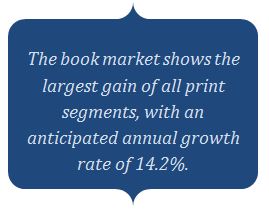It’s inevitable; growth and change go hand in hand. Today’s book publishing industry is a perfect example of this philosophy.
InfoTrends’ 2010–2015 U.S. Digital Production Printing Application Forecast explored 28 specific application segments and measured digitally printed application volume changes in several key market segments, including book publishing. The book market shows the largest gains of all segments, with an anticipated annual growth rate of 14.2%. 1. This represents more than 45 billion pages by 2015. 
In another August 2011 study, the Association of American Publishers (AAP) and the Book Industry Study Group (BISG) released U.S. BookStats—one of modern publishing’s most comprehensive statistical surveys. It captured size, scope, revenue, and expansion across multi-platform content and sales distribution channels. Net sales for publishers increased to $27.94 billion in 2010, representing a 5.6% increase over 2008. Publishers sold 2.57 billion net units in 2010, marking a 5.6% increase over 2008. Growth hit all segments. Higher education textbooks were up 18.7%, with sales reaching $4.55 billion in 2010. Sales of trade books grew 5.8% to $13.9 billion.
The growth is evident with all numbers pointing upwards for book publishing with the largest increases in print on demand. Print-on-demand (POD) publishing is destined to grow in volume at the expense of conventional printing. One reason is print quality; digital printing has made great strides within the last decade. By pushing technology to the limits, POD offers a valuable solution over conventional publishing.


